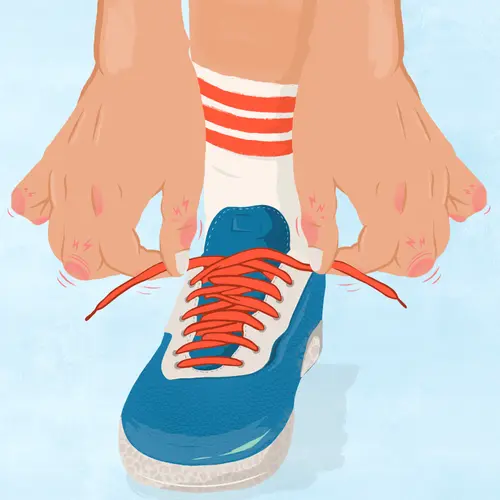How long do you need to take a disease-modifying antirheumatic drug (DMARD) for rheumatoid arthritis before it's fully effective? It depends on which one you use. But they all take a while, says Eric M. Ruderman, MD, a rheumatologist at Northwestern Medicine Rheumatology in Chicago. In fact, he says, DMARDs used to be called SARDs, slow-acting antirheumatic drugs.
When you take DMARDs, it usually takes 6-12 weeks to see a response, according to Ruderman. Why so long? Well, to explain that, it helps to understand what DMARDs do.
How Do DMARDs Work for RA?
Once, nonsteroidal anti-inflammatory drugs (NSAIDs) such as ibuprofen and naproxen were the main treatment for rheumatoid arthritis (RA). They treat joint pain and inflammation. They do not prevent joint damage. If these didn’t do the trick, your rheumatologist might consider giving you a DMARD, which was a newer type of medication.
That's changed in the last 15-20 years, says Ruderman. Now, DMARDs are prescribed as soon as you’re diagnosed with RA. Why? “We recognize that just treating symptoms really doesn’t cover it. You have to treat the underlying disease. That’s what gives you the best long-term outcomes,” he says.
Each type of DMARD works differently. But they all go beyond treating symptoms to block inflammation and slow the disease process. This minimizes the joint damage and complications that inflammation from RA can cause, such as heart problems, says Ruderman.
“People really belong on a disease-modifying drug right out of the gate because our goal these days is not just to manage the symptoms, but to put people in remission if we can. And we can most of the time,” Ruderman says.
NSAIDs and corticosteroids are an important part of an RA treatment plan, too, but they only improve symptoms caused by inflammation. DMARDs are the foundation because they work with your immune system to slow down or even stop the disease
.
Why Do DMARDs Take So Long to Work?
Because a DMARD medication treats underlying inflammation, “it’s not going to work overnight," Ruderman says.” People often see some benefit right away, but it usually takes longer to ease symptoms like swollen, painful joints and morning stiffness, he says.
“The other complicating factor is that, particularly for methotrexate, there are dose issues,” Ruderman says.
Your rheumatologist will probably start you on a low dose for about a month. If that doesn't help enough, your doctor may bump up the amount. It usually takes about 3 months to get to a point where you and your doctor can decide whether the medicine is working. With some kinds of DMARDs, it takes up to 6 months for the maximum benefit, he says.
What Are the Different Types of DMARDs?
Your doctor can choose from among conventional DMARDS, which fight inflammation by working on your immune system as a whole, and biologic DMARDs, which target certain proteins involved in the immune response.
DMARD drugs used for RA include:
- Azathioprine
- Hydroxychloroquine
- Leflunomide (Arava)
- Methotrexate (Rheumatrex, Trexall)
- Sulfasalazine
- Biologic DMARDs known as tumor necrosis factor inhibitors, such as adalimumab (Humira), certolizumab (Cimzia), etanercept (Enbrel), golimumab (Simponi), and infliximab (Avsola, Inflectra, Remicade, Renflexis,)
- Biologics called B-cell inhibitors, including rituximab (Rituxan, Ruxience, Truxima)
- Biologics called selective costimulation modulators, such as abatacept (Orencia)
- Janus kinase inhibitors, such as baricitinib (Olumiant), tofacitinib (Xeljanz), and upadacitinib (Rinvoq)
Methotrexate is usually the first DMARD doctors prescribe for people with RA. Hydroxychloroquine, leflunomide, and sulfasalazine are also common treatments.
Ruderman says leflunomide and methotrexate usually take the longest to reach full effectiveness.
Biologic DMARD drugs are quicker. “We often expect to see some meaningful benefit by about 6 weeks, sometimes sooner,” says Ruderman.
The newer kinase inhibitors, which include tofacitinib and upadacitinib, work fastest, he says. “I typically expect to see a benefit within about a month,” he says.
What Does Successful Treatment Look Like?
The ideal outcome is that you end up in remission.
“That’s our goal, especially if we treat people early,” Ruderman says. “It’s hard to know exactly, but somewhere between 60% and 75% of the time, we can actually get people into remission.” This may take several tries with different medications.
Ruderman defines remission as no swollen, painful, or tender joints. You might have a day every week or two where you don’t feel great or are achy in the morning, but this improves quickly. “For the most part, you just don’t feel like the disease is an issue in your life,” he says.
Unfortunately, if you’ve had RA for years, you probably already have a lot of damage, Ruderman says. That's because the older treatments weren’t as effective. DMARDs can’t undo past damage from RA. But they can slow down the disease and may prevent further harm to your joints.
How Do You Know Which Drug Is Best for You?
While RA treatments have come a long way, there’s no way to predict which medication will work best for you. You may have to try three or four medicines to find one that gets results.
“It’s great that we have so many good drugs, and they all work really well,” says Ruderman. “We just don’t have a good way to choose between them.”
How Long Do You Need to Take DMARDs?
“The answer is pretty much forever,” Ruderman says. “RA is a lifelong disease and none of the medicines we have cure it. They control it.”
Once you find something that works, you should be able to use it for up to 15-20 years before you need to try something else. So far, research has shown that stopping your medicine altogether, even when you’re in remission, causes symptom flare-ups.
“It’s just not worth it,” says Ruderman. But your rheumatologist may be able to taper your dose a bit or let you go longer between doses once you’re in remission.

